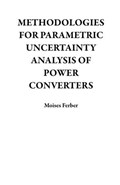The development of semiconductor technology in the last decades has boosted the number of new applications in which power electronic devices have been employed. The fast switching of transistors has allowed power conversion to be performed with high efficiency. However, this improvement brought a new challenge in design: Electromagnetic Compatibility. The rapid voltage and current pulses inside power converters are a source of unwanted conducted electromagnetic emissions. High accurate modeling methodologies, which takes into account most of the parasitic phenomena, have been developed, in order to compute the level of conducted emissions of electronic devices. When these methods are confronted with measurement, they show good agreement in a large frequency range, and thus they are considered a trustful prediction tool for electronic systems design. Nevertheless, most of the parameters of the model of any electronic system, in reality, cannot be determined precisely, due to unknown operation conditions (i.e.: temperature or humidity variations), production dispersion of the components or unpredictable external interference. In this context, it is of great interest to develop modeling methodologies which are able to take into account parametric uncertainty. In this thesis, two methodologies for uncertainty analysis of power converters are proposed. The parametric uncertainty is modeled using probability density functions and the objective of the proposed analysis is to determine the statistical moments, the probability density function or a probabilistic upper bound for the conducted emissions of an arbitrary power converter. Techniques to tackle the difficulties of nonlinearity, long simulation time and high-dimensionality are discussed. The proposed methodologies are applied to test and real-world problems and the results are confronted to classical approaches. The accuracy of the results is similar to classical methods, although the required computational time is significantly reduced. Finally, this work leaves many possibilities for further development in the field of uncertainty analysis of nonlinear, high-dimensional systems.

